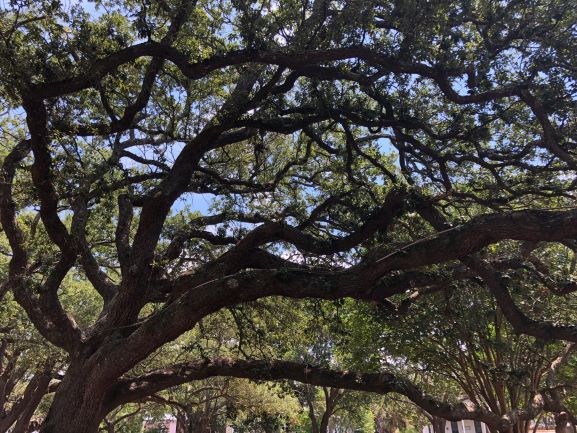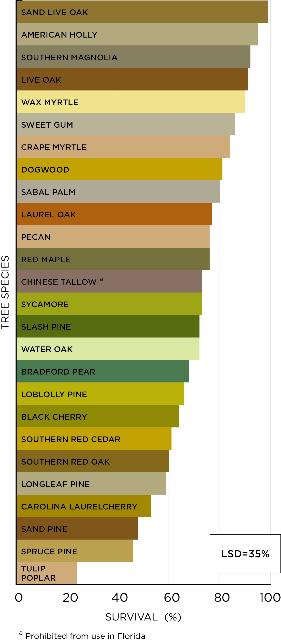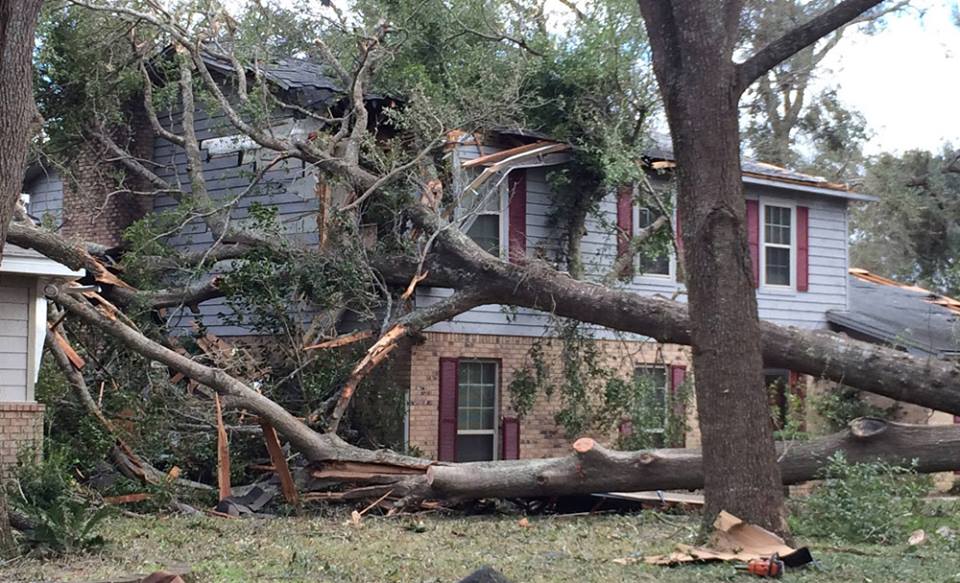The Pensacola area has had its fair share of rough weather lately. While the recent storms were not hurricanes, the rainfall totals rivaled many tropical storms, and the lighting and wind were disastrous. A tornado caused significant damage, including a tragic death, with more tumultuous weather in the forecast. Our rainy hurricane season has just begun, so it is worth talking about tree selection, management, and preparing for storms.
After the busy 1992, 1995, 1998, and 2004-05 hurricane seasons, several University of Florida researchers undertook an exhaustive on-the-ground project to look at tree damage statewide. Their goal was to determine which species survived high winds, and which trees were the most vulnerable during storms. Their findings were consistent, and have held up over the past few decades. A full description of the project can be found online, along with several publications that go over proper pruning and maintenance of trees, both before a storm and after recovery.

For the “coastal plain” of north Florida, the most wind-resistant species are: live and sand live oaks (Quercus virginiana/Q. geminata), American holly (Ilex opaca), Sabal palm (Sabal palmetto), Southern magnolia (Magnolia grandiflora), bald cypress (Taxodium distichum), Florida scrub hickory (Carya floridana), dogwood (Cornus florida), sweet gum (Liquidambar styraciflua), and crape myrtle (Lagerstroemia indica). The live oaks and sweet gums do have a tendency to lose branches, so it is important to undertake proper pruning in the off season to trim up potential problem limbs.

Courtesy M. Duryea and E. Kampf
Live oaks, and sand live oaks (which live on coastal sand dunes) are slow-growing trees with extraordinarily dense wood. This protects them in hurricane-force winds. Part of the working theory on why bald cypress, holly, and magnolia do well in storms is their pyramidal shape, which seems to allow wind to whip circularly around the trees and avoid damage. Sabal palms are botanically considered part of the grass category and not trees, so their single, flexible trunk allows them to handle the onslaught of wind. Sweetgums are particularly hardy in tornadoes, due to their sturdy root system and shorter, “stout” branches. Smaller understory trees like crape myrtle and dogwood are likely dodging the strongest winds, but also have strong branch structures and dense wood. These two species, along with sand live oak, also lost an average of more than 80% of their leaves. This defoliation is an adaptation to heavy winds, with trees that lost leaves performing better overall than species that held onto their leaves but toppled at the trunk.
The least wind resistant species, according to the studies, included: sand pine (Pinus clausa), loblolly pine (Pinus taeda), and spruce pines (Pinus glabra), laurel and water oaks (Quercus laurifolia/Q. nigra), Southern red oak (Quercus falcata), Southern red cedar (Juniperus silicicola), Carolina laurelcherry (Prunus caroliniana), black cherry (Prunus serotina), Loquat (Eriobotrya japonica), pecan (Carya illinoensis), sycamore (Platanus occidentalis), tulip poplar (Liriodendron tulipifera), Bradford pear (Pyrus calleryana), and red maple (Acer rubrum). A couple of pine species—slash and longleaf—performed in the medium range. In my experience post-hurricane, many of these trees that survived were stressed and ended up with pine bark beetle infestations. Water and laurel oak are common trees in Florida home landscapes, but typically have much shorter lifespans than live oaks. They are faster growing but have weaker wood, and are vulnerable to storms.

Another list of tree survivability was developed for residents in tropical and subtropical regions of the state. If you have friends or family in south-central Florida, be sure to share this information with them.
Besides planting wind-resistant species, the research team shared other observations related to tree planting and arrangement, too. Single trees are more vulnerable than trees planted in clusters, as they protect each other from incoming winds. Older trees, and those with preexisting damage, are more likely to fall. Trees with plenty of space around their roots do better—if a tree is surrounded on two or more sides with buildings or other hard surfaces, they cannot spread adequately. Detailed information on identifying damaged or poorly structured trees, along with maintenance and pruning tips, can be found in the “Urban Forest Hurricane Recovery Program” series of articles written by the UF tree specialists involved in the studies. The publications include good diagrams and photos of specific examples.
- The Praying Mantis - June 20, 2025
- Bluebirds in Florida - May 8, 2025
- The Brahminy Blind Snake - April 10, 2025
